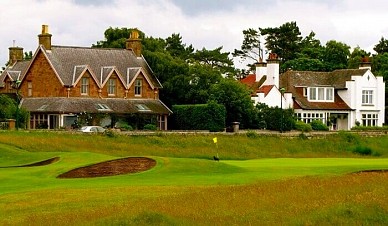Walk in the Footsteps of Legends and Enjoy a Golf Round at Pinehurst No. 2
Pinehurst Resort, Golf Course Reviews, North Carolina, Pinehurst No. 2
As the most famous golf course at this iconic resort, Pinehurst No. 2 was designed in 1907 by Donald Ross. The golf architect said that the course was "the fairest test of championship golf" he has ever built, and he has been associated with Pinehurst Resort for roughly half a century. In 2010, Pinehurst No. 2 was restored by Coore & Crenshaw.
While the praise it has received from every influential figure in the sport's history over the years could fill a book, one thing is for sure – Pinehurst No. 2 isn't a course you'll play once, check off your list, and forget, as this is a golf course you'll most likely return to over and over again. We encourage you to walk Pinehurst No. 2, as you'll miss a lot if you ride.
As cliché as it may sound, the golf course will test every part of your game on almost every hole. Some of the defining characteristics of Pinehurst No. 2 are wide fairways, bunkers with ragged edges and wire grass, firm conditions, inverted saucer greens, and lack of water. The aesthetic variety the golf course achieves without water or dramatic elevation is impressive.
How to Navigate Pinehurst No. 2 for a Mind-Blowing Golfing Experience
Considering the difficulty Pinehurst No. 2 entails, it can easily become a golf course that makes you love to hate yourself. While it's undeniable that veteran players will have a significantly easier time conquering this challenging golf course, anyone can play and enjoy the experience as long as they're not dead set on achieving perfection.
Perhaps the best par 3 is the 9th hole. As you already know, Pinehurst No. 2 is one of the most demanding approach shot courses in the world, featuring green complexes that will test your game, and the 9th hole is a great example in this respect. The right third of the green slopes off the edges, whereas the rest of it is heavily surrounded by bunkering. Anything that doesn't reach the putting surface will require accurate work to save par.
As for the best par 5, this is without a doubt the 5th hole, which played as a par 5 in the original design and until the 1951 Ryder Cup, when it was converted to a tough two-shotter. The hole doglegs to the left around a waste area. Slopping from right to left, the fairway will take approximately 300 yards to clear the bunker on the left if you try to shorten the hole.
Here is a short description of what to expect when playing each hole at Pinehurst No. 2:
- Hole 1 (par 4): there's a lot of room to drive your ball, and the hole isn't too long, but you'll get a glimpse of the challenges to come.
- Hole 2 (par 4): the key to successfully playing this one is the angle of approach, and a drive toward the left side of the fairway is advised.
- Hole 3 (par 4): while it offers a good birdie opportunity, you should be conservative on the approach shot, as there is trouble over the green.
- Hole 4 (par 4): this hole is reachable for long hitters, but it's a three-shot hole for average players, and you should be cautious of the bunkers approaching the green.
- Hole 5 (par 5): because the fairway slopes abruptly from right to left, it's best to favor the right side with your tee shot.
- Hole 6 (par 3): a slope off the front of the green repels shots that are hit short of the target, and it's advised to use a long-iron or fairway wood.
- Hole 7 (par 4): it's the sharpest dogleg on the golf course, and a series of bunkers on the right corner can grab tee shots pushed to the right.
- Hole 8 (par 5): with the green dramatically slopped from back to front, approach shots missed long or left can make for a challenging up-and-down.
- Hole 9 (par 3): for this hole, club selection is crucial, as most difficulty can be found to the left and behind the putting surface.
- Hole 10 (par 5): this is the longest hole on the golf course and entails a birdie opportunity if you use fairway wood.
- Hole 11 (par 4): while the fairway appears wide, it is bordered with classic Pinehurst trademarks, namely wire grass, hardpan sand, pine needles, and pinecones.
- Hole 12 (par 4): as a dogleg, this hole demands a precise tee shot, and a left-center shot will enable you to reach the best angle into the green.
- Hole 13 (par 4): for this hole, club selection is essential, and you should also avoid the fairway bunkers on your tee shot.
- Hole 14 (par 4): your tee shot should favor the right side of the fairway so that you avoid the bunker on the left and the four bunkers on the right.
- Hole 15 (par 3): this is a long and challenging hole for players of any skill level, and you should favor the front position of the green for a successful shot.
- Hole 16 (par 5): after your first tee shot, you should avoid the hidden bunker on the left of the fairway, near which your second shot should land.
- Hole 17 (par 5): for this hole, you should take enough club, as right-side locations are the most difficult, and there is also a birdie opportunity.
- Hole 18 (par 4): you should avoid the long, deep bunker down the right side off the tee, but the greenside bunker short right is very tough.
The last hole of Pinehurst No. 2 is the signature hole of the golf course. You'll most likely experience intense emotions when playing the 18th hole, as well as the challenge of a 451-yard uphill two-shotter and the history of those who have been there before you. Bunkers work as a wall of defense in front of the elevated green and require a high, soft approach shot.
The Takeaway
Pinehurst Resort is undoubtedly iconic, as it's the place where the story of American golf began and where it continues to thrive today. If we've sparked your interest in playing a memorable round at the legendary Pinehurst No. 2, don't hesitate to book a Pinehurst Resort golf package and enjoy what this picturesque destination has to offer!






